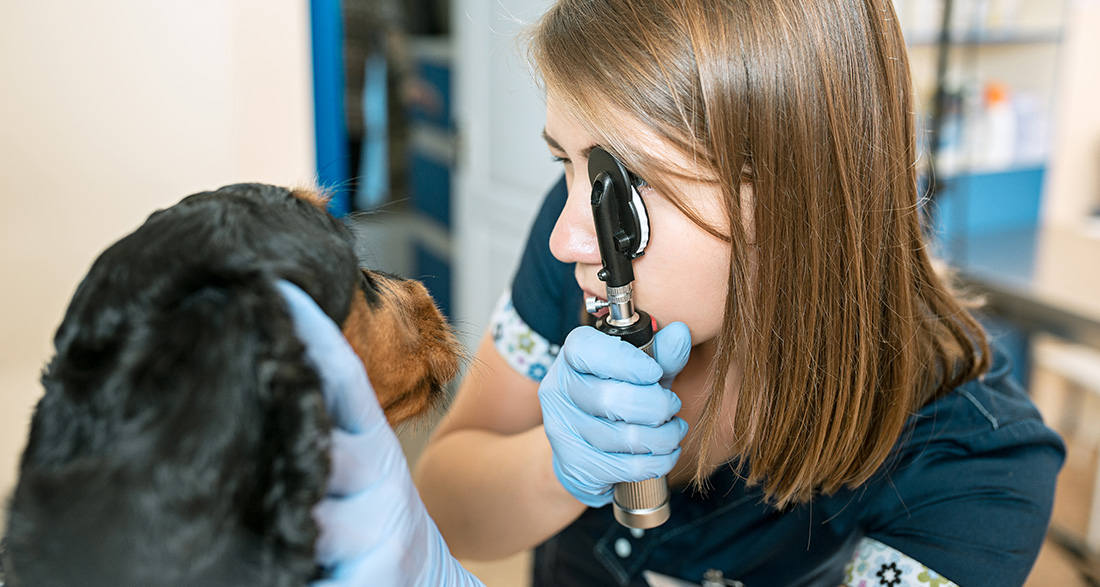Cherry Eye, or prolapse of the nictitating membrane gland, is an eye condition in dogs that is painful and can lead to further issues such as dry eyes, inflammation, and vision problems. A prompt initiation of therapy is crucial to prevent these complications. But how can dog owners recognize if their dog has Cherry Eye, and what treatment options are available in such cases?
What is Cherry Eye in Dogs?
Dogs have three different eyelids: an upper, a lower, and the nictitating membrane or third eyelid. The nictitating membrane contains the nictitating gland, which produces a portion of the tear fluid. The nictitating membrane gland, located protected beneath the eye, is stabilized by cartilage and tissue. If these are too weak or if the gland enlarges (“nictitating membrane gland hyperplasia”), it protrudes over the eyelid and becomes visible from the outside.
The term “Cherry Eye” is derived from this appearance. By the way, you can learn more about the behavior and health of dogs in our dog guide.
Symptoms: How does Cherry Eye manifest in dogs?
When a dog has a prolapse of the nictitating membrane, it is relatively clearly recognizable for the owner: the Cherry Eye is visibly a red structure at the inner corner of the eye. Additionally, the conjunctiva and eyelids are usually red.
In the initial period after the prolapse, a watery eye is typical, while in the later course of the disease, it leads to a dry eye and frequent blinking. The dog may squint the eye more or attempt to scratch it.
What consequences can arise from Cherry Eye?
Untreated, the prolapse of the nictitating membrane quickly leads to conjunctivitis. Often, not enough tear fluid is produced due to the displacement of the gland, favoring chronic dry eyes. Moreover, it rarely remains limited to one Cherry Eye. After some time, many cases show a prolapse of the nictitating membrane on the other eye of the dog.
Causes: How does Cherry Eye develop in dogs?
The exact cause of a prolapse of the nictitating membrane gland in dogs is not fully understood to this day. It is assumed that it is particularly inherited, especially in short-nosed dog breeds.
The age of the dog also seems to play a role in the development of the disease: older dogs develop Cherry Eye if they tend to have dry eyes or suffer from eye tumors. However, Cherry Eye more commonly affects relatively young dogs—especially those under two years old.
Breeds that seem to have an increased risk of a prolapse of the nictitating membrane gland are:
- American Cocker Spaniels
- Beagles
- English Bulldogs
- French Bulldogs
- Lhasa Apsos
The higher occurrence in short-faced dog breeds is presumably due to the fact that there is less space for the organs in the head. The nose is often shorter, and the eye sockets are shallower. This causes the eyeballs not to lie deep in the eye sockets but rather to rest flatter on them.
In large dog breeds, the problem is more likely related to the fact that the cartilage supporting the nictitating membrane is too long. This makes it easier for the nictitating membrane to fold outward and protrude from the eye. This is occasionally the case with Great Danes, for example. However, a prolapse of the nictitating membrane gland due to connective tissue weakness, chronic eye irritation, or a tumor is also possible.
How is Cherry Eye treated?
In the case of a prolapse of the nictitating membrane, it is important to restore the nictitating membrane to its original position. In some dogs, it returns to its place on its own, but often, inversion under local anesthesia by the veterinarian is necessary. Removal of the nictitating membrane gland is not beneficial, as it leads to insufficient tear fluid production, resulting in dry eye.
Before surgery, dog owners can treat their pet’s eye with a soothing ointment from the veterinarian to prevent drying out and inflammation. As an operative measure, fixing the nictitating membrane in its original position is suitable. In this process, the cartilage is usually corrected, and the inner side of the nictitating membrane is tightened, preventing it from protruding again. The postoperative care after such a nictitating membrane gland hyperplasia surgery includes:
- Antibiotic eye drops and antibiotics in tablet form
- Possibly a preparation against inflammation and pain
- Wearing an Elizabethan collar or another device to prevent the dog from scratching the eye
It is also important to protect the dog during the eye healing period. Drafts should be avoided to prevent inflammation. Regular postoperative check-ups and possibly suture removal are then performed by the veterinarian.
What is the prognosis for Cherry Eye disease?
It happens that the nictitating membrane gland returns to its correct position on its own, but usually, surgery is unavoidable. Whether this surgery is successful and the gland remains permanently fixed behind the eyelid depends on several factors:
- How long did the Cherry Eye exist before treatment?
- Was there already an inflammation, and if so, how advanced was it?
- How large is the nictitating membrane gland of the dog?
- How stable are the cartilage and connective tissue?
- How shallow is the eye socket of the animal?
- Is the eye still growing, or is the dog already fully grown?
- How well do the surgical sutures hold, and how good is the postoperative care by the dog owner?
In general, there is a good chance of a permanent improvement in the prolapse of the nictitating membrane gland. It is crucial that pet owners consult a veterinarian and initiate treatment as soon as possible after the first symptoms appear. It is also essential to follow the veterinarian’s instructions for postoperative care.


